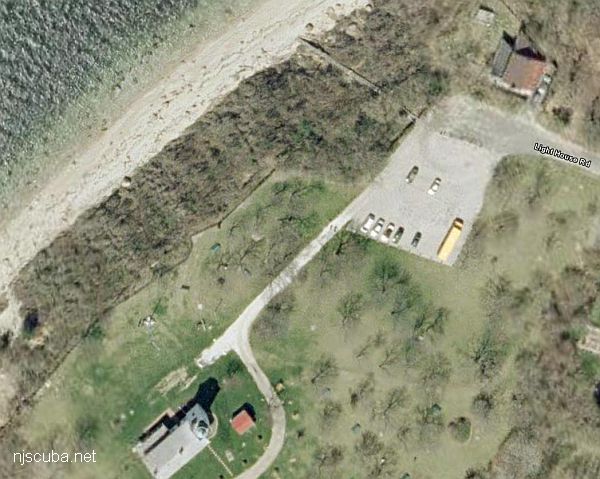Side-scan Sonar (2/3)

Side Scan Sonar
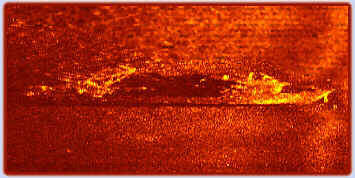
by Daniel Berg
Searching for shipwrecks has always been a difficult and sometimes costly endeavor. There are several methods divers have used to conduct these searches. In many cases, divers would go out to check "hang numbers" from a local fishing boat. The spot which caused the fisherman's rig to "hang" could be anything from a single pipe to a virgin wreck. Other divers have invested time and money in machines like proton magnetometers which register anomalies when passed over any metallic object. Targets produced would then be investigated by the divers who could find the metallic object, which many times produced only 55-gallon drums. Some sophisticated wreck hunters even utilize side scan sonars which use sound waves to scan the ocean floor. In the past these machines could cost up to $100,000. Underwater searching technology has just entered the twentieth century and wreck hunters now have a new toy. Mike McMeekin and I met Doug Blaha from Marine Sonic Technology, Ltd at DEMA 95. Doug demonstrated to us some barge and wreck images he had stored in his computer. The images were so impressive that we arranged for a real-life ocean demonstration. Seeing is believing in my eyes.
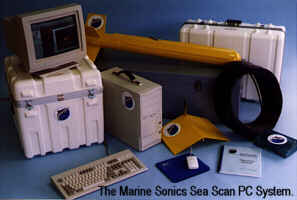
In the spring of 1995, Doug Blaha and Pete Wilcox of Marine Sonic came to New York to demonstrate Marine Sonics new Sea Scan PC Side Scan Sonar. This new patented technology is so advanced and yet comparably affordable that it was hard to believe Doug's claims. Doug first explained that the best way to "see" underwater is with sound. Underwater, light is quickly diffused and very ineffective. Even the brightest light yields only a few feet of visibility. A good analogy is a room filled with thick heavy smoke. Bright lights are nearly useless but sound travels well through the room. Fishermen have employed fish-finding sonars for years with good success. Fish finding sonars look down through the water and display objects appearing above the bottom. Side-scan sonar is engineered to look sideways through the water. Doug explained that the Sea Scan PC Side Scan Sonar was unique in at least three significant areas, cost, performance, and operability. He claimed that the Sea Scan PC was an affordable, high-tech system featuring performance unequaled by systems costing three times as much or more. It is portable, easy, and contains features only made possible with a high-performance personal computer.
Cost was, of course, the first thing that went through my mind. Marine Sonic utilizes a PC instead of a dedicated processor. PCs are manufactured in the millions thus significantly reducing one of the most expensive components of a side-scan system. Added benefits from the PC are an integrated plotter for navigation, digital processing, filtering, and enhancement of data and the ability to store images on disk rather than the hard thermal paper normally associated with most side scan systems.
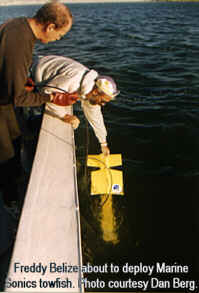
We boarded the Wreck Valley joined by Captain Steve Bielenda, Captain John Lachenmayer, and Mike McMeekin, and started to scan shipwrecks. Marine Sonics fresh approach to side-scan technology comes from the medical field. Using low power and extremely low noise electronics, the sonar emits very short, precision pulses in narrow-focused beams to produce clean, crisp near-photographic images. Pete demonstrated how easy it was to deploy and tow their transducer carrying fish tow. They then interfaced the computer with the Wreck Valley's loran and brought up a plotter display. We then inputted the TD's of a known shipwreck and were able to not only see a visual reference (Marker) of the wreck on the plotter, but also the position and the area we had already scanned. Doug showed how a simple keystroke changed the scanning distance or swath width. The unit is capable of scanning up to 500 meters to either side of the vessel but we would be looking for better resolution and therefore scanning at around 100 meters of the ocean floor. Once we passed over the wreck the image appeared on the computer screen. There was no interpolating the image or wondering what we were seeing. The image of the wreck, the Black Warrior, was clear and we could easily recognize details like the wreck's boiler, mast and low-lying debris field. For the rest of the day we cruised around the ocean scanning wrecks, in fact, we imaged nine wrecks in one day! Doug also continued to impress us with the machine's versatility. He demonstrated how we could get larger more detailed images by scanning the same site on a smaller scale or by only scanning off one side of the towfish. He showed how the Sea Scan PC could measure objects on the bottom and how it could triangulate to calculate the relief of the target. To say the very least everyone on the boat was very excited. We had learned more about the actual layout and surrounding areas of these nine wrecks in one day than in the last ten years of diving. We even found several targets that we want to go back and investigate on SCUBA.
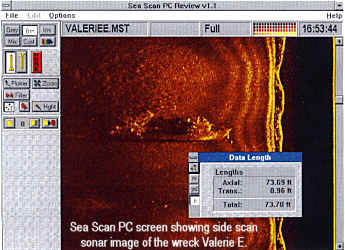
Operability, on most sophisticated side-scan units mandates a trained professional technician. The Sea Scan PC unit, however, is extremely user-friendly. In fact, almost anyone who has ever operated a personal computer can learn the basics in just a few hours of practice. The superior performance and ease of use claimed by Doug was easy to prove. Even with yours truly behind the controls of the computer we continued to produce quality images. Experience is very important, but new operators will quickly grasp the principles and recognize the key features. Since data is stored on a hard disk in the computer, images can be reviewed later after returning from sea in the comfort of home or office.
Side-scan sonar is the technology of the future that will enable us to not only produce more accurate underwater sketches of known wrecks but to search and identify new sites to dive. For additional information on the Sea Scan PC Side-Scan Sonar contact Marine Sonic Technology, Ltd., 5580 George Washington Memorial Highway, White Marsh VA 23183-0730 or call them at (800)447-4804. I will also be running a hands-on basic side-scan course/expedition where we will be searching for an undiscovered shipwreck. For course details, you can contact me at AquaExplorers, Inc. at (516)868-2658.
About the Author: Dan Berg is the author of ten shipwreck and diving-related books, and the host & producer of the award-winning Dive Wreck Valley television series.
Original NJScuba website by Tracy Baker Wagner 1994-1996

